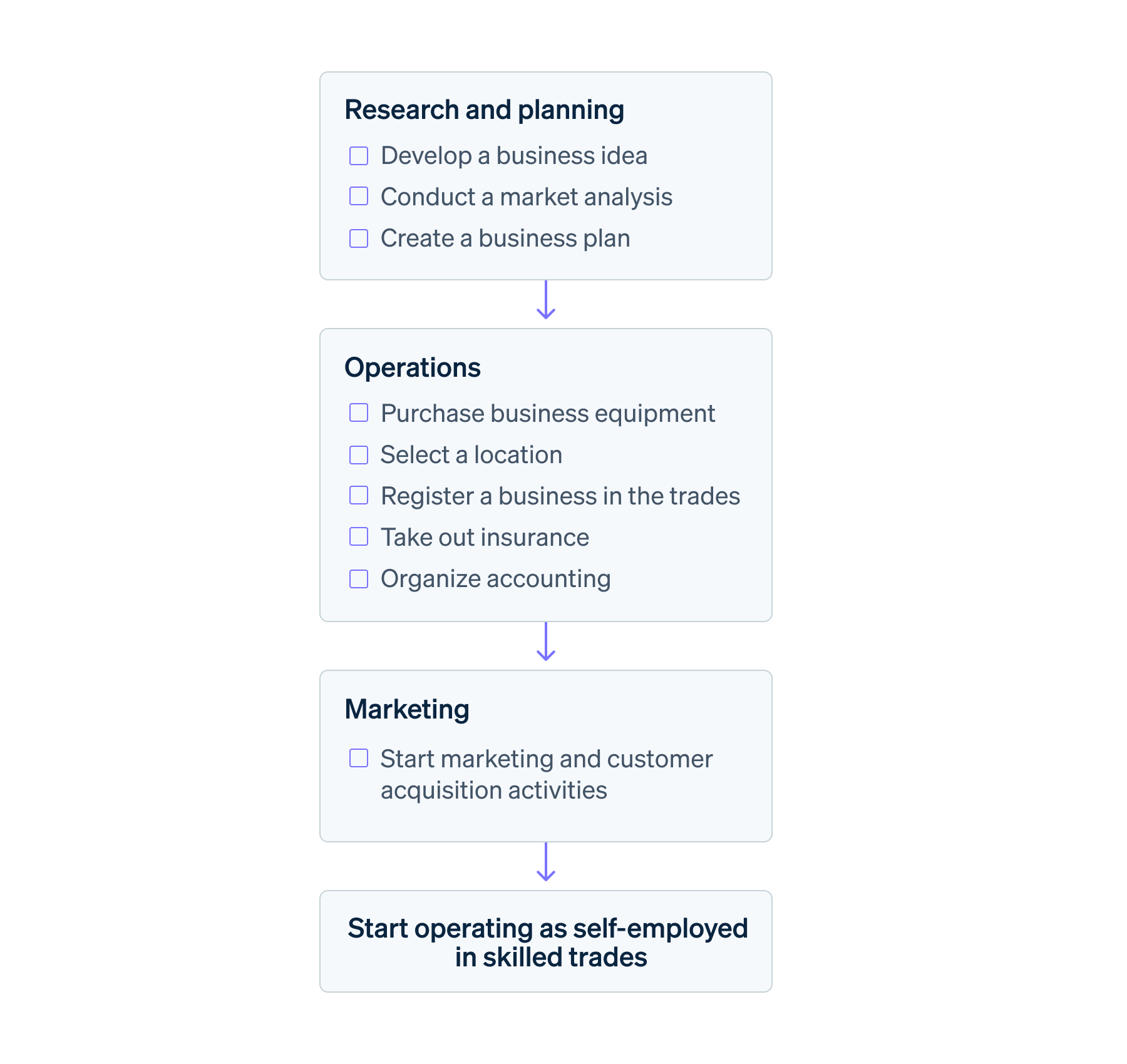根据德国手工业协会,德国当前该行业有超过 100 万家企业,约有 560 万名雇员。如果您不希望受雇于某个手工艺企业,而是想创业,可以选择走自雇之路。本文解释了独立工作的个人、专业和法律要求,以及何时需要持有工匠师傅证书。我们还分步讲解了如何创办自己的企业、预期的费用以及作为自雇者的潜在收入。
目录
- 成为自雇工匠的要求是什么?
- 何时需要工匠证书?
- 如何在手工业领域创业?
- 成为自雇工匠需要多少成本?
成为自雇工匠的要求是什么?
成为自雇工匠需要满足多个专业和法律要求。
专业要求
工作经验是专业能力和客户信任的基础,它能证明您的技能已在实际操作中得到了验证。多年工作经验不仅有助于您精通技艺,还能帮助深入理解职业的流程和挑战。这也有助于有效解决问题、精确估算工作成本以及成功经营业务。
此外,商业知识对于独立工作也是必要的。自雇工匠必须计算支出、准备报价和创建账单、管理预算、缴税并组织财务。掌握这些技能有助于保持价格竞争力、清晰了解收支状况并确保长期盈利。即便是经验丰富的企业家,拥有这些知识也能帮助业务保持良好的财务状况。
法律要求
扎实的职业培训是手工业自雇成功的基础,有助于学习专业的实践和理论知识。然而,在某些情况下,仅有培训还不足以实现独立工作——还需要持有工匠师傅证书。
自雇工匠还必须遵守某些法律要求,以确保其业务合法经营。这包括在相关部门注册(如贸易和税务局、相关行业协会),并遵守合同和雇佣法律。尤其是,他们必须遵守职业健康和安全规定,确保员工安全。此外,工匠需遵守合规的会计原则(基于 GoBD,即“电子形式的账簿、记录和文件的妥善管理和存储原则”)。
工匠还需考虑合适的政策,以满足法律要求并确保业务的财务安全。例如,商业责任保险是保护公司免受损害索赔的关键,法律和伤残保险也是重要的选择。
何时需要工匠证书?
在德国,超过 130 种职业被归类为手工业工种,分为以下七大类:
- 建筑与扩建
- 服装、纺织和皮革工艺
- 健康与个人护理、化学和清洁工艺
- 平面设计
- 木材和塑料
- 食品工艺
- 金属和电气
根据德国的手工业条例 (HwO),这些职业分为需要许可证和不需要许可证的职业。前者需要从手工业协会 (HWK) 获得工匠师傅资格证书才能在该领域开展业务。这项资格基于职业培训,并作为工艺、艺术、技术商业和农业专业的额外资格。
如果您没有工匠师傅证书,但想在需要许可证的工种中成立公司,您可以聘用一名全职的工匠师傅担任管理职位,或采用所谓的“工匠制规定”。这要求创始人证明自己至少有六年的工匠经验,其中至少四年担任管理职务。
需要许可证的手工业领域通常要求完成工匠师傅考试,主要是为了满足特定的质量标准和安全要求。例如,这适用于电工、屋顶工和管道工。《手工业条例》附录 A 列出了需要许可证的职业。附录 B则涵盖了不需要许可证的工种,包括制表师、鞋匠和摄影师。
如何在手工业领域创业?
任何希望在手工业行业自立的人都需要按结构化步骤开展,以满足所有法律和组织要求。以下是启动这类业务的最重要步骤:

第 1 步:制定商业理念
首先,您需要明确您想提供哪些产品和服务以及目标客户是谁。基础是您所学和实践的专业技能。同时,您必须检查该工种是否需要许可证。确保您具备在该行业自雇所需的专业资格。制定清晰的商业创意应以明确定位为目标,最好具备独特卖点。
第 2 步:进行市场分析
第二步是分析现有市场。是否存在对您产品或服务的需求?市场的规模和潜力如何?您的业务将在哪些地理区域运营?谁是您的客户,谁是您的竞争对手?您还需要确切地知道您的竞争对手提供什么,他们的价格,以及他们的市场份额。同样要关注进入壁垒和影响您业务的一般及区域性趋势。您的评估越详细,对自身业务的准备就越充分。
第 3 步:选择地点
选择合适的业务地点与市场分析密切相关。该地区应便于供应商和潜在员工的接入,并接近客户。例如,开设面包店的门店会从繁忙的环境中受益,而屋顶施工公司则可以选择较不中心的位置,因为实际工作是在客户场所进行。关键是该地区要符合所有法律要求并适合业务运营。
第 4 步:制定商业计划
第一步到第三步为创业过程中的另一个关键步骤做好准备:制定商业计划。这包含了您的研究和决定的结果。商业计划应包含您的创意、市场分析、目标客户群、计划的营销策略、资金需求和成本核算。
这对结构化您的项目、规划融资以及向潜在投资者展示商业创意都非常重要。
第 5 步:购买业务所需设备
创业的另一个关键步骤是购买必要的设备。具体工具、机器和材料的选择取决于行业需求。可能还需要车辆来运送员工和物资。务必遵守所有安全标准和法律要求,例如储存危险材料或设置机械的规定。
这些设备还包括处理行政流程的硬件和软件,如会计程序、时间记录与计费软件以及用于客户管理和订单处理的数字工具。若您希望在现场接受客户付款,可了解更多关于 Stripe Terminal 的信息。通过 Terminal,您可以使用 Stripe 读卡器 S700 或移动设备如 BBPOS WisePad 3 进行现场支付。不需要额外设备即可实现无现金支付,支持 Tap to Pay 功能。
第 6 步:注册工匠企业
根据企业的法律结构,正式要求会有所不同。大多数自雇工匠需要在手工业协会 (HWK)、商业登记处和税务部门进行注册。在许多情况下,还需要登记入商业登记簿并成为相关专业协会的会员。雇佣员工的企业必须向社保部门申报员工。
第 7 步:购买保险
在开始运营之前,您需要获得所有必要的保险,尤其是商业责任险。
第 8 步:组织会计
适当的簿记是法律要求的,有助于您跟踪收入、支出和税务情况。在个别情况下,咨询税务顾问可能会有所帮助。您还可以使用像 Stripe Invoicing 这样的工具来自动生成和发送账单,从而节省大量的行政工作时间并帮助防止出现计费错误。您还需设置一个商业账户,以便区分私人和业务现金流。
第 9 步:启动营销和客户获取活动
理想情况下,您的营销概念已包含在商业计划中。这包括专业网站、传单、行业目录中的提交信息,以及可能在选定的社交媒体平台上进行展示。吸引客户的关键是尽早开始营销和客户开发。
第 10 步:开始运营
一旦完成所有法律和组织方面的准备,您的公司即可接受第一笔订单。
工匠企业创业的 10 个步骤:
成为自雇工匠需要多少成本?
启动业务的总费用因企业类型、规模和个体需求而异。通常,您至少需要支付几百欧元,没有上限。以下是一些主要成本:
- 培训,包括获得工匠师傅证书
- 在税务部门等机构注册
- 运营设备,例如工具和机器、车辆和信息技术设备
- 经营场所的租金及其他费用
- 保险
- 税务咨询
- 市场营销和广告
- 人员、材料和用品的持续运营成本
自雇工匠能获得多少收入?
自雇工匠的收入差异很大,主要取决于行业类型、地区、订单情况、运营成本和员工数量。这主要取决于贸易类型、地区、订单情况、运营费用和员工人数。通常,手工业的小时费率为净收入 50 至 80 欧元。您可以将此费率乘以预期工作小时数,以估算月收入。不过,您也需要考虑管理任务的工作时间。最后,还需要扣除您的费用。
本文中的内容仅供一般信息和教育目的,不应被解释为法律或税务建议。Stripe 不保证或担保文章中信息的准确性、完整性、充分性或时效性。您应该寻求在您的司法管辖区获得执业许可的合格律师或会计师的建议,以就您的特定情况提供建议。